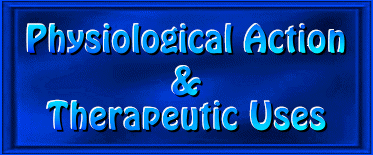


The following is excerpted from The Professional's Herbal Formula Handbook No. 16, comprising 119 pages of traditional information and recent scientific data that describes the medical properties, physiological action and therapeutic uses for each of the 24 ingredients outlined in this formula.




Adaptogenic, alterative, amphoteric, anabolic, analgesic, anesthetic, anodyne, mild antibiotic, anti-cachexic, anti-dyscratic, anti-infective, antioxidant, antiphlogistic (anti-inflammatory), antiseptic, antispasmodic, bacteriostatic (anti-bacterial), cytophylactic, cytotoxic, decongestant, deodorant, depurative, detoxicant, diaphoretic, disinfectant, diuretic, fungistatic (anti-fungal), hormonagogue, immuno-modulator, immuno-potentiating, immuno-stimulant, microbicidal (anti-microbial), spasmolytic, stimulant (circulatory and secretolytic), stomachic, tonic, constitutional tropho-restorative, vasodilator and viricidal (anti-viral).


Alleviates any general fluids dyscrasia (abnormal or pathological condition) within the blood vessels, bone tissue or skeletal structure, musculature, and the mucous membranes or tissue-systems throughout the entire organism that leads to the onset of various degenerative or debilitative conditions during pregnancy or childbirth (including anemia, anxiety, depression, fatigue, hormonal imbalances, impaired or retarded growth conditions, painful spasmodic disorders, stress or general weakness), and eliminates any cachexia (state of malnourishment and general debility) throughout the entire organism in order to provide increased protection against any systemic or localized nutritional deficiencies or insufficiency that leads to difficult or painful childbirth or pre-natal conditions; displays antispasmodic and spasmolytic properties in order to soothe and relieve any localized abdominal aches or neuralgic cramping sensations associated with the onset of pregnancy, as well as any irregular painful or spasmodic conditions associated with the initial stage of labor; demonstrates antispasmodic and spasmolytic properties in order to ease any spasmodic pains, while calming and relaxing the musculature in the womb; exhibits cytophylactic and cytotoxic activity in order to provide stronger cellular defense mechanisms against many physical or chemical agents, and displays anti-infective and disinfectant properties in order to promote increased resistance by destroying any invasive or harmful pathogenic bacteria, microbes or viruses that are often responsible for various infectious states or inflammatory conditions; exhibits bacteriostatic and microbicidal activity in order to strengthen and increase the resistance of the fetal tissue and the female reproductive system against any invasive or harmful bacteria or microbes, as well as to inhibit the further development of any infectious or inflammatory conditions associated with the onset of pregnancy or lactation; displays significant bacteriostatic (anti-bacterial), fungistatic (anti-fungal), and systemic microbicidal (anti-microbial) effects against Staphylococcus aureus, Streptococcus spp. and other hyaluronidase-secreting bacteria or microbes, due to the presence of fixed (caffeic acid glucoside) or volatile oils (polyacetylenes) and echinacoside glycosides; demonstrates anti-infective activity by inhibiting the secretion of the enzyme hyaluronidase in order to alter hyaluronic acid which possesses cellular protective effects; acts as an extremely effective broad-spectrum natural antibiotic (due to the presence of echinacin), and displays antiphlogistic and viricidal activity (due to the presence of polysaccharides); demonstrates significant antiphlogistic effects in order to inhibit the formation of certain inflammatory compounds (such as histamine, leukotrienes, prostaglandin, serine proteases and thromboxanes), as well as to reduce any severe inflammatory swelling associated with any degenerative conditions by exerting an extremely positive influence towards correcting any internal inflammatory conditions within the female reproductive organs (including mammitis); exhibits significant antiseptic activity by destroying the vitality of any organized living ferments in order to prevent the onset of putrefaction or septicemia, and precipitates the proteins in any inflamed tissues in order to provide a mildly antiseptic and protective coating (under which the regeneration of new tissue occurs) for the mucous membranes and tissue-systems throughout the entire female reproductive system; acts as an effective antiseptic in order to remove any septic conditions associated with tissue degeneration or ulceration, and promotes increased suppuration and a steady toning or restorative impression to the entire glandular system (especially the liver, spleen and lymph glands); displays antioxidant properties in order to reduce the number of free radicals that produce harmful damage upon the DNA and RNA, as well as upon the various enzymes or cellular membranes throughout the entire organism; exhibits anabolic activity in order to accelerate the production of DNA and RNA (which enhances the production of proteins in the form of antibodies), while increasing protein and lipid synthesis in the bone marrow and DNA/RNA content in the adrenals and lymph nodes (along with increased body weight and enhanced re-synthesis of glycogen and high-energy phosphate compounds); displays amphoteric effects in order to normalize or regulate the functional capabilities of the female reproductive system (as well as to regulate proper hormonal levels), and alleviates any estrogen or progesterone deficiencies or insufficiency by promoting increased estrogen and progesterone levels; exhibits hormonagogue activity in order to stimulate increased hormonal secretions by the adrenal cortex in order to enhance the overall metabolism of carbohydrates, fats and protein, thereby acting as a preventative against the onset of any protein deficiencies or insufficiency (kwashiorkor); demonstrates powerful adaptogenic (balancing and strengthening) activity in order to increase the overall resistance of an organism towards any adverse influences or stressful conditions (whether they be physical, chemical or biological), especially throughout the immune system, blood vessels, musculature, skeletal structure, and both the central (cerebro-spinal centers) and peripheral nervous systems; exhibits powerful immuno-potentiating and immuno-stimulatory effects (due to the presence of the water-soluble polysaccharide echinacin B) in order to enhance greater long-term immune potential and overall systemic immunity (or immune cell activity) and increased immune response (by activating the body's natural defense mechanisms), particularly in relation to the removal or restoration of any degenerative conditions during fetal growth or development; enhances the body's ability to become resistant to many viral or bacterial infections by stimulating the production and subsequent activity of several chemical mediators of immunity (immune mechanisms that are not controlled or mediated by antibodies), thereby increasing resistance towards various infectious conditons; intiates increased antibody production in response to the presence of viruses, mold-like bacteria, yeasts, fungi, parasites and various other microorganisms or invasive agents, and provides greater resistance to these pathogenic microbes and infective organisms by stimulating and strengthening the body's own defense mechanisms (or immune system) and eliminating poor immune response in order to ward off disease; prevents the spread of any harmful microorganisms by enhancing the body's ability to inhibit the secretion of hyaluronidase, which is secreted by various microbes for the purpose of increasing the permeability of the surrounding connective tissue (formerly referred to as the "spreading factor"); strengthens the natural immune defense mechanisms by releasing natural sources of insulin (inulin) and enhancing the production of the serum protein properdin (due to the presence of the muco-polysaccharides) in order to activate the alternative complement pathway, which increases non-specific host defense mechanisms such as the neutralization of viruses, the destruction of harmful pathogenic bacteria or microbes, and the increased migration of white blood cells (B-lymphocytes, neutrophils, basophils, eosinophils, monocytes, etc.) to specific areas of infection; accelerates the responsive capabilities of the white blood cells to attack and digest any harmful pathogenic bacteria, toxic immune-complex proteins, and the larger viruses associated with those conditions involving influenza, herpes, encephalomyocarditis, or vesicular stomatitis; activates significant and potent immuno-stimulatory effects or activity via the alternative complement pathway by utilizing specific types of polysaccharides that are able to adhere or bind themselves to certain carbohydrate receptor sites located on the cellular surface of the T-lymphocytes (or T-cells) and other white blood cells in various cellular membranes, resulting in non-specific T-cell activation (including the increased production and secretion of interferon and any other system-potentiating compounds), enhanced T-cell mitogenesis (reproduction), increased macrophage phagocytosis (general cellular immunity involving the scavenging, engulfment and destruction of harmful pathogenic bacteria or viruses by specialized cells), antibody binding, natural killer (NK) cell activity, and increased levels of circulating neutrophils (white blood cells that are primarily responsible for defending the organism against harmful invasive bacteria); increases T-cell transformation in order to enhance the cytotoxic destruction of virally-infected cells and the release of interferon (which blocks the replication of both DNA- and RNA-containing viruses or bacteria by binding itself to the cellular surfaces and stimulating the synthesis of proteins in the form of antibodies), thereby preventing the further invasion of pathogens or development of viral infections while stimulating the growth of fibroblasts (in order to increase the production of new tissue) by inhibiting intercellular diffusion and inflamed swelling (due to decreases in hyaluronic acid activity); acts as a secretolytic stimulant in order to promote increased gastric, pancreatic or intestinal secretory and motor activity, and enhances greater peripheral circulation (due to its antioxidant activity); exhibits significant antioxidant effects in order to provide greater oxygen-transport capabilities throughout the mother and fetus, as well as enhance the transport of additional oxygen directly into the cells and tissue-systems throughout the female reproductive system; acts as a circulatory stimulant by increasing the blood flows throughout the circulatory system in order to enhance greater nutrient transport, absorption and utilization, thereby accelerating the healing processes associated with the repair of any nutritional deficiencies or insufficiency throughout the entire organism; eliminates any septicemia (the presence and persistence of various pathogenic microorganisms or their toxins in the blood) or uremia (retention of excessive by-products of protein metabolism in the blood that leads to various toxic conditions such as autointoxication), and neutralizes any acid conditions in the blood that are characteristic of lymphatic stagnation; ; activates the bodily processes of detoxification and elimination in order to cleanse and purify the bloodstream and tissue-systems, and increases both sensible and insensible perspiration in order to more effectively enhance the eliminative capabilities of the body; enhances the overall cleansing process by dilating the surface capillaries in order to more effectively remove any toxic debris or metabolic waste materials through the pores of the skin, and increases the secretion and elimination of urine in order to provide further support to the inner cleansing process; displays alterative activity in order to correct any disordered bodily function, thereby activating increased alterations in both metabolic and tissue functions as a defensive measure against the onset of acute or chronic disease; exhibits restorative effects in order to regain increased vigor or vitality and greater strength, while enhancing normal tissue and metabolic functional capabilities; demonstrates alterative and restorative properties in order to re-establish healthy systemic functional capabilities, as well as to establish greater vascular tone throughout the entire organism (due to its ability to stimulate increased secretory flows); exhibits alterative effects in order to stimulate the anabolic growth processes, thereby enhancing the repair of any degenerated, deteriorated and debilitated cells or tissues (while promoting the elimination of any catabolic waste materials); displays tonifying effects in order to permanently enhance the overall energy-levels throughout the entire organism, without adversely affecting the functional capabilities of any particular organ or system.
![]()
None.
![]()